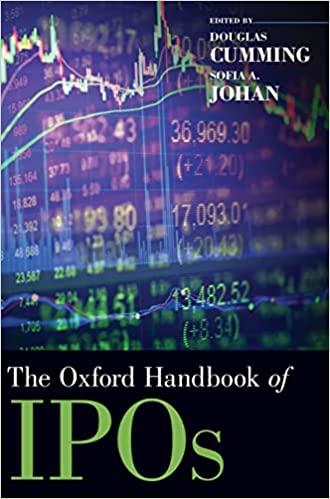Question
Go to a website such as www.investinginbonds.com or another site where you can solve the follwing exercise. 1. Find a corporate bond with a coupon
Go to a website such as www.investinginbonds.com or another site where you can solve the follwing exercise.
1. Find a corporate bond with a coupon rate over 5 percent, a maturity rate of less than six years in the future, a high price of at least 70, and a yield of at least 5 percent.
2. You are going to use the same techniques of the below table to calculate the duration of the bond. You will need a calculator for ease of computation. Below is a sample table.
| (1) | (2) | (3) | (4) | (5) | (6) |
| Year | Cash Flow | PV Factor at 12% | PV Factor of Cash Flow | PV FActor of Annual Cash Flow (4) / Total PV of Cash Flows | Year * Weight (1) * (5) |
| 1 | 80 | 0.893 | $71.44 | 0.0835 | 0.0835 |
| 2 | 80 | 0.797 | $63.76 | 0.0745 | 0.1490 |
| 3 | 80 | 0.712 | $56.96 | 0.0666 | 0.1998 |
| 4 | 80 | 0.636 | $50.88 | 0.0595 | 0.2380 |
| 5 | 80 | 0.567 | $45.36 | 0.0530 | 0.2650 |
| 5 | 1,000 | 0.567 | $567.00 | 0.6629 | 3.3145 |
| Total PV of cash flows = 855.40 | Duration = 4.42498 |
4. With the bond you have chosen in Step 1 and using the above table as a template, do the following:
a. Set up column (1). Even if the bond you have selected does not end in exactly a given number of years, round to the nearest year.
b. Set up column (2). Use the coupon rate on the screen and multiply it times $1,000 to get cash flow. Also, assume a $1,000 cash flow in the final year.
c. To get the discount rate in column (3), round the yield value on the screen to the nearest whole number.
d. Compute the present value of the cash flows for each year, and sum them as is shown in column (4)
e. To get the values in column (5), divide each value in column (4) by the sum of column (4)
f. Multiply the year number in column (1) by the values in column (5) to get the values in column (6). When you total the values, you have completed the process of computing duration.
5. How does the duration of the bond compare to the bond's rounded value for maturity? What percentage of maturity does it represent?
6. If interest rates go down by 2 percent, how much will this bond price increase? Use the following formula and remember to change the sign to positive in your answer:
% change in the value of a bond = Duration * Change in interest rates
Step by Step Solution
There are 3 Steps involved in it
Step: 1

Get Instant Access to Expert-Tailored Solutions
See step-by-step solutions with expert insights and AI powered tools for academic success
Step: 2

Step: 3

Ace Your Homework with AI
Get the answers you need in no time with our AI-driven, step-by-step assistance
Get Started


